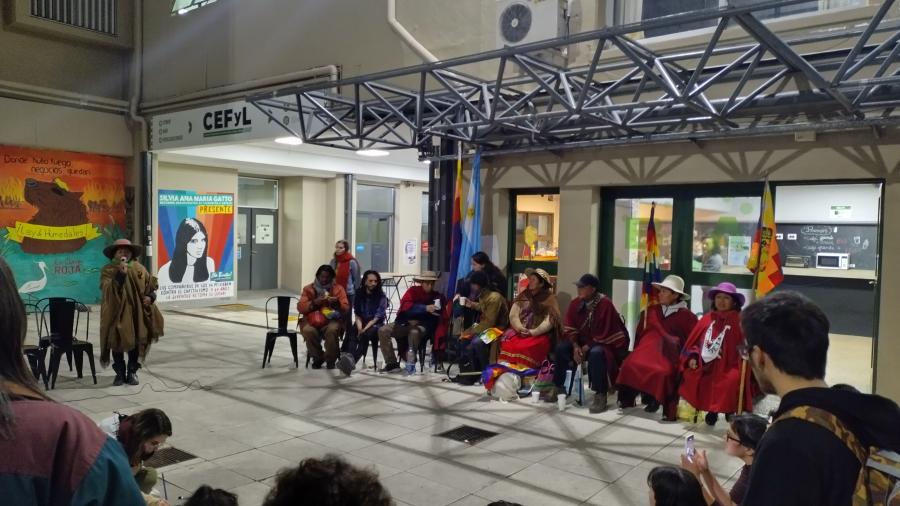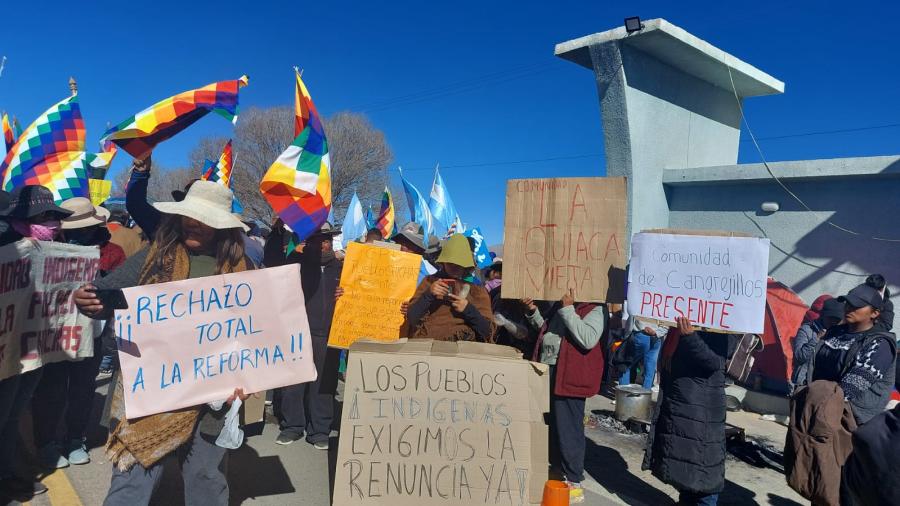By the end of this decade most of rural Latin America will be incorporated into major national and international telecommunication networks. In this sudden, quantum leap to space-age telecommunications, indigenous communities living in rural, "frontier" areas, whose experience with television and even radio has been minimal or nil, will become "linked" to satellite technology. The modernization of communications is widely acclaimed by Latin American governments as necessary for national economic development and socio-political integration. Powerful multinational corporations and the governments of industrialized nations foster this line of thinking which supports their own interests. The Third World, considered an expanding market, represents a multi-billion dollar Third World telecommunications market.
Thus, it is no surprise that Brazil, Colombia and Mexico last year were considering a number of different domestic satellite system proposals from several multinational corporations.
India and Indonesia have already established (within the last five to eight years) their own domestic satellite-based telecommunications systems which will reach thousands of villages with commercial and educational television and radio for the first time. Venezuela, Colombia, Ecuador, Peru, Chile, Argentina, most of the Arab nations and still other Third World states are currently considering the acquisition of their own satellite-based telecommunication systems.
The government of Australia has just placed an order worth $175 million with the U.S.'s Hughes Corporation, for its own satellite system, reportedly to enable television and radio broadcasts to reach remote, isolated areas and Native Peoples of the continent. In Canada and Alaska there are areas where satellite-carried television programming has been altering the culture and economy of Native Peoples for a number of years.
Mexico and Brazil have announced contracts with Hughes Corporation and Canada's Spar Aerospace, respectively worth $95 million and $125 million. Both systems are to be delivered within the coming three to five years, both are to be financed mainly with foreign loans (Export-Import Bank of the U.S., and international finance agencies), and both are to make telephone and commercial and educational radio and television available virtually throughout each nation, with business-oriented services, such as telex, data and facsimile transmissions available to the main urban centers. The large indigenous populations of these countries are already affected by the mere fact that these decisions have been taken.
In Colombia, recent administrations have expanded and modernized the national telecommunications system as part of general economic development strategies. The last administration's program for development (1978-1982) was officially titled National Integration, and in early 1982, the Colombian Satellite Project, Satcol (Satelite Colombiano) was formalized through the signing of a non-binding agreement with NASA (the U.S.'s National Aeronautics and Space Administration) for the launching of the Colombian system with the Space Shuttle in June, 1985. However, mounting public concern over what was feared to be undue pressure exerted on the government by U.S. corporations doubtless contributed to the incoming administration's decision to reconsider the awarding of a contract until later this year.
Although Colombian foreign policy has shifted toward the Non-Aligned Movement, the final outcome, however, could still be to go ahead with the project. While technical arguments support this outcome (satellite costs have decreased while their efficiency and lifespan have increased), the entire scheme is in the interest of powerful internal and external sectors:
* national and multinational industry - including the so-called high technology sectors of advanced capitalism, such as computer hardware and software, the electronics field, and space technology
* central government efficiency and control in administration and security matters, especially in light of considerable recent guerrilla activity
* U.S. multinational and domestic advertising agencies, which account for the bulk of Colombian and Latin American mass media revenues and which support media growth
* U.S. multinational mass media content industries, such as the major film corporations, the television networks and the major distributors, whose products dominate Latin American and Third World markets.
Rural Latin America is one of the most likely targets for the expansion of Western markets. Soft-drink ads, western reruns, national soap operas and network news coverage (a major television news program in Colombia already inserts a U.S. network's product when covering international news) are already inundating the market.
Significant steps have been taken in Colombia to integrate through satellite territories that make up the eastern third of the country. Six urban centers - Arauca, Puerto Carreno, Mitu, Puerto Inirida, Puerto Leguizamo and San Vicente del Caguan - received satellite dish antennas late in July of 1982. In addition, two areas in the Northwest - Acandi and Bahia Solano - received antennas in 1982. Two larger frontier cities had previously received their antennas; San Andres in 1978, the tourist and commerce island dependency off the coast of Nicaragua, whose Native black, English-speaking population has been relegated to a back seat in the commercial development of the island; and Leticia (in 1970), the main port on the Colombian Amazon River, in the heart of a growing commercial and tourist area whose original indigenous inhabitants have largely been set aside in the general development of the area.
All of these domestic linkages will facilitate national commercial and educational television and radio broadcasts to these centers, as well as direct telephone/telex access to/from Bogota, the rest of the nation, and the international sphere. The connections were made by leasing satellite capacity from Intelsat (the single, predominant commercial agency that offers satellite communication channels on a worldwide bas
An overall view of the six urban centers that have just been linked, in terms of the indigenous communities living in the areas, reveals that although approximately 100,000 indigenous inhabitants of the Eastern Territories are in varying economic, social and political situations, their common struggle for their lands unifies their interests.
The mass media, industry, commerce, tourism and bureaucratic sectors that are to benefit from the satellite links offer little support in this basic struggle; on the contrary, they tend to consolidate non-indigenous institutions, further denying the urgent needs, history and culture of native communities.
However, in spite of this, there will necessarily be air time available for regional, national and even local programming and broadcasting efforts that support indigenous concerns. In this sense, a new space exists for alternative, creative uses of technology in support of the self-determination of indigenous communities. A critical understanding of the predominant industries as they penetrate these new areas of the continent will be essential, however, if this potential benefit is to be realized.
The satellite antennas in Puerto Inirida, Mitu and Leticia represent the further penetration of Colombia's Amazon River Basin tropical forests, where the most isolated indigenous groups of the country reside. However, local and regional broadcasts in these areas are possible. Several years ago little attention was paid to a foreign embassy's offer to donate radio-station equipment exclusively for use by indigenous communities; today there is in fact a need for such equipment.
Indigenous community leaders and schoolteachers in the area are capable of and anxious to intervene and modify the educational offerings that the government makes in their communities. Generating awareness of the need to create and protect land reservations was a major concern for some of these schoolteachers, as was the need to address larger, national audiences about indigenous peoples and their culture.
On the plains of the Orinoco River Basin, the satellite antenna of Arauca represents the consolidation of the livestock economy of the area which caused the reduction of the once nomadic and semi-nomadic Guahibo and Cuiva and forced them into sedentary lives on little-recognized reservations. In Puerto Carreno satellite links represent the further penetration of what have been called the last indigenous lands of the Colombian plains - the Vichada territory. As the struggle for establishing reservations and acquiring new economic and social ways continues (many Guahibo have initiated cattle-raising and cooperative farming for regional markets), local broadcasting aimed at supporting this process could reach all 20,000 Guahibo by way of, for example, a single television set in each village. Still, who controls programming is an essential issue.
Satellite antennas at Puerto Leguizamo and San Vicente del Caguan ultimately support the massive migration process by landless, impoverished farmers from the interior. This migration has depleted the regional forests and reduced indigenous communities to small reservations and to the bottom of the new socioeconomic structure. At the top are large landholders and businessmen.
In spite of dubious results in India, Indonesia and in the Brazilian educational rural television experiment of the late sixties, it is clear that Latin American rural communities are in need of alternative uses for mass media, as mass media become less alien and potentially more alienating to them than ever before.
Article copyright Cultural Survival, Inc.



